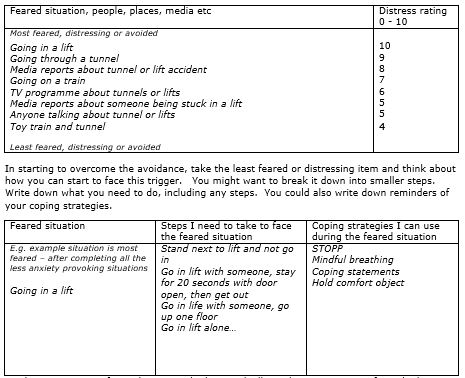Phobias Self Help
Self help guide for Phobias, using effective CBT strategies. Make sense of the problem, then learn how to make positive changes
A phobia is a fear of a particular thing or situation. Phobias can often have a first triggering event, which then results in the individual feeling very frightened when they then think about, see or are reminded of the feared object / situation.
When a person with a phobia sees or is reminded of the feared object or situation, their mind says they are in danger, which sets off the body's alarm system (adrenaline) resulting in our experiencing many different body sensations. These feelings seem to confirm that we are indeed in terrible danger, and we feel an urge to escape. To stop us experiencing these feelings, we will try to avoid seeing or hearing about the feared object or situation.
Cognitive Behaviour Therapy helps us learn to challenge the unhelpful thoughts and beliefs, combined with gradual exposure to the feared object or situation.
See this page for information about anxiety and the normal body response.
Example of a simple vicious cycle of phobia
SELF HELP FOR PHOBIAS
Cognitive Behaviour Therapy focuses on learning to challenge the unhelpful thoughts and beliefs, and gradually making changes in our behaviour so that we learn that the feared consequences do not happen, and that it is the anxiety that makes us feel the way we do.
In order to break the vicious cycle of anxiety attacks when exposed to our phobia trigger, we need to change the way we think, and change what we do. Firstly, we can learn about how any anxiety affects our body. This is the body's normal response to danger (or believing we're in danger):
- Read Alarming Adrenaline
These physical feelings of adrenaline are normal - it is simply the body's alarm system being activated in order to help us escape from a dangerous situation. So it feels dangerous, even if it really isn't.
The feelings will pass. If we could just notice the thoughts and feelings, and not react to them by believing them to be dangerous in themselves, if we could breathe deeply and focus on our breathing and allow the thoughts and feelings to come, and go, then the adrenaline will calm down within a few minutes.
NEEDLE & BLOOD PHOBIAS
With most phobias, the adrenaline response causes our blood pressure to rise, and our heart rate to speed up. This means we are physically unable to faint, even if the adrenaline makes us feel light-headed or dizzy.
However, there are two exceptions to this rule: needle and blood phobias cause a different reaction whereby the increase in blood pressure can be quickly followed by a drop, which causes us to faint. So in cases of needle and blood phobias (and only needle and blood phobias) we can learn to reduce the possibility of fainting, using the applied tension technique.
- Sit in a chair and tense the muscles in your arms, legs and body (NOT your head or face) for 10-15 seconds.
- Hold the tension until you feel a warmth spread into your face or head.
- Release the tension for 20-30 seconds and return your body to its normal sitting state.
- Repeat the exercise 5 times over a period of about 5 minutes.
- Practise several times a day for at least a week.
- After a week, you can start using the technique when you're working through your Avoidance Worksheet doing exposure exercises (for needle and blood phobia).
If this technique triggers headaches, make sure you are tensing ONLY your body, arm and leg muscles, and NOT your face and head muscles.
Thinking Differently - Challenging Thoughts
If we can change the way we think about a situation or about the normal anxiety feelings, then we will not feel so anxious. We can learn to challenge those anxiety-provoking thoughts. We tend to over-estimate the dangerousness of the object or situation and the risk of the worst thing happening, and under-estimate our ability to cope if bad things do happen. Thoughts are not statements of fact. Don't believe everything you think!
- Learn more About Automatic Thoughts
- Learn Fact Or Opinion skill
- Learn about The Mind Bully
- Flexible Thinking
Thoughts are just thoughts. We look at life, and situations through distorted lenses. Just because we think this situation or object is dangerous doesn't mean that is how it really is! We are looking at the object or situation, through those very distorted lenses, perhaps as a result of an early experience. There is often an event, earlier in our lives, that happened that could help explain this phobia.
- Read: Different Perspectives
Learn to challenge the unhelpful and distorted thinking:
- Use the Vicious Cycle & Alternatives PDF to map out your own thoughts, feeling and behaviours, and generate some healthier alternative thoughts and behaviours.
- Use this Anxiety Thought Record Sheet PDF to help learn to challenge the thoughts or use the generic Thought Challenge Webpage or The Court Case
- Find out the facts behind what you fear. Ask others to help you. Learn about the actual risk of bad things happening, and how people cope if bad things do happen. Fact Or Opinion?
- Practise STOPP skill
- Learn to use Positive Coping Statements
Thinking Differently: Re-Focus
When we think about being in a situation or when we start to feel anxious, our focus of attention gets totally caught up in the perceived danger and how awful we feel. Our thoughts and the adrenaline makes us feel an overwhelming urge to escape. It can be a horrible experience which leaves us feeling battered and exhausted afterwards - we just want to escape that situation to stop the feelings - and avoid it happening again.
It is very helpful to learn how to change our focus of attention and take more control over how we react to thoughts and feelings. We can learn to just notice the thoughts and physical sensations of anxiety, acknowledge them, then let them pass. Notice the Mind Bully and let it go - turn your focus of attention to something else. First of all, you might learn to focus on your breathing.
- Practise Mindful Breathing
Then you might learn and practise Mindfulness skills including Mindful Activity. It's important to practise these skills frequently, every day, so that when you NEED them, you'll be able to use them effectively.
Notice: Where my attention is.
Observe: What I'm doing. Think: "I am walking", "I am sitting",
"I am breathing", then notice those sensations in your body
Wise Mind: What now? How shall I continue? Doing or Being?
NOW: Mindfulness For Busy People leaflet
MINDFULNESS FOR BUSY PEOPLE
- Choose an activity to do mindfully throughout the day, for one, two or five minutes. For example: Drink a cup of tea. Walk. Wash the dishes.
- Whatever you are doing, be in that moment, right now. See, hear, smell, touch, feel, breathe.
- Simply notice whenever other thoughts and sensations come to mind, then re-focus on your chosen mindful activity.
- Be patient and compassionate with yourself.
- Describe - rather than judge good or bad, pleasant or unpleasant.
- It is as it is.
Everything Flows. Nothing is fixed. Heraclitus
NOW: Mindfulness For Busy People PDF
Doing Differently
Our usual strategy for dealing with phobias, is to avoid our feared object or situation. However, although that helps us avoid becoming anxious, avoiding those objects or situations (where you might be exposed to the fear) just serves to keep the anxiety and panic going because we never find out that things will be ok.
See Overcoming Avoidance to gradually face your fears.
Slowly, we can change what we do. Use the Avoidance Worksheet PDF to identify what you don't do or where you don't go, then start by gradually exposing yourself to the least feared situation in the list, using healthy coping strategies in those situations.
Aim to do things gently and gradually, starting with the least feared situation, and gradually work your way up your list to the most feared. For example if you phobia is of enclosed spaces, then your avoidance list may look like this, with the bottom section for your "most feared" completed (after having worked your way up through the list).
It's important that you see the situations through - stick with the anxiety - it will pass.
Use STOPP skill to incorporate many strategies
STOP - just pause for a moment
Take a Breath - one slow deep breath
Observe - there's the Mind Bully again. My body and mind is reacting to the thoughts and anxiety feelings.
Pull back - this is just the anxiety talking. Don't believe everything you think! Let's stick with the facts - these thoughts are just opinions (Fact Or Opinion). This situation is safe - the evidence says so. What's the Helicopter View? The awful danger is imagined and my mind is tricking me. These thoughts and feelings are normal - it's just the body's alarm system doing its job, when it doesn't need to. I can stick with this situation, in order to help me overcome this phobia. It will pass.
Practise / Proceed - What can I do right now? I can use these strategies:
-
Thought Challenge webpage or The Court Case
-
Avoidance Worksheet pdf (or Avoidance Webpage)
Where can I put my focus of attention right now? (Mindfulness & mindful activity). What else can I do that would help me tolerate these thoughts and feelings without reacting to them?
Complete your own STOPP Worksheet PDF
PHOBIAS SELF HELP - this page as PDF
Self Help Resources For Phobias
- HELP FOR ANXIETY - NOW !
-
PHOBIAS SELF HELP - print this page as PDF
- Read Anxiety Self Help
- Practise Mindful Breathing and/or Colour Breathing
- Practise STOPP
- Read Fact Or Opinion
- Read About Automatic Thoughts
- Overcome Avoidance
- Practise completing the Vicious Cycle & Alternatives
- Work your way through the 7 Step CBT Self Help Course: substitute the Panic Thought Record Sheet for the generic Thought Record/Challenge Sheet
- Self Help Videos
- The Worry Tree
- The Mind Bully
- Problem Solving
- Use The Self Help MP3s
Self Help Books
An Introduction To Coping With Phobias
Introducing Overcoming Phobias: A Practical Guide
Resources
- HELP FOR ANXIETY - NOW !
-
PHOBIAS SELF HELP - print this page as PDF
- Read Anxiety Self Help
- Practise Mindful Breathing and/or Colour Breathing
- Practise STOPP
- Read Fact Or Opinion
- Read About Automatic Thoughts
- Overcome Avoidance
- Practise completing the Vicious Cycle & Alternatives
- Work your way through the 7 Step CBT Self Help Course: substitute the Panic Thought Record Sheet for the generic Thought Record/Challenge Sheet
- Self Help Videos
- The Worry Tree
- The Mind Bully
- Problem Solving
- Use The Self Help MP3s
Self Help Books
An Introduction To Coping With Phobias
Introducing Overcoming Phobias: A Practical Guide






















